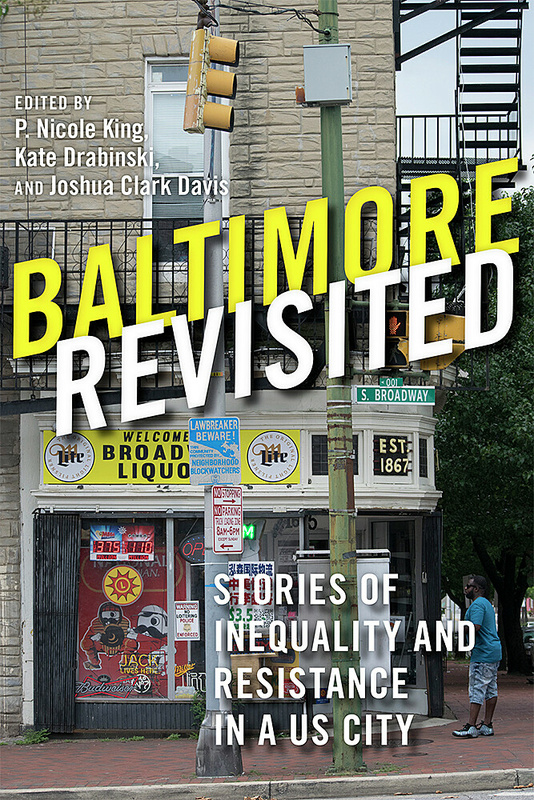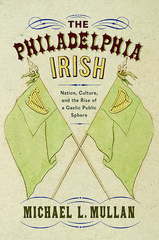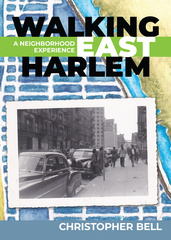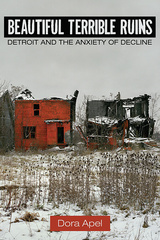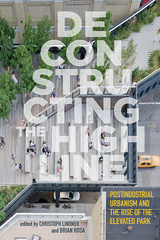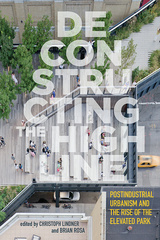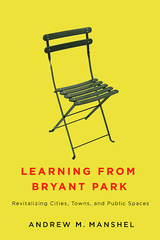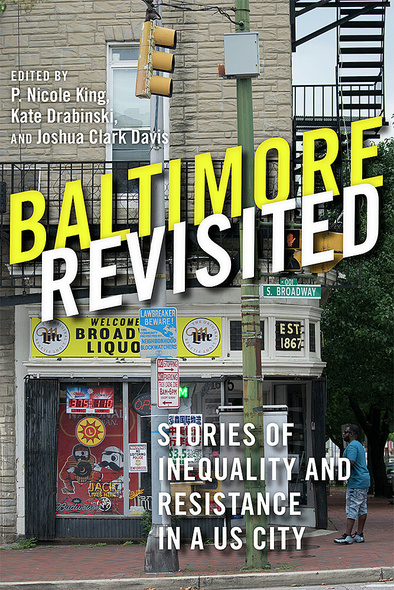
378 pages, 6 x 9
24 b-w images
Paperback
Release Date:09 Aug 2019
ISBN:9780813594019
Hardcover
Release Date:09 Aug 2019
ISBN:9780813594026
Baltimore Revisited
Stories of Inequality and Resistance in a U.S. City
Rutgers University Press
Nicknamed both “Mobtown” and “Charm City” and located on the border of the North and South, Baltimore is a city of contradictions. From media depictions in The Wire to the real-life trial of police officers for the murder of Freddie Gray, Baltimore has become a quintessential example of a struggling American city. Yet the truth about Baltimore is far more complicated—and more fascinating.
To help untangle these apparent paradoxes, the editors of Baltimore Revisited have assembled a collection of over thirty experts from inside and outside academia. Together, they reveal that Baltimore has been ground zero for a slew of neoliberal policies, a place where inequality has increased as corporate interests have eagerly privatized public goods and services to maximize profits. But they also uncover how community members resist and reveal a long tradition of Baltimoreans who have fought for social justice.
The essays in this collection take readers on a tour through the city’s diverse neighborhoods, from the Lumbee Indian community in East Baltimore to the crusade for environmental justice in South Baltimore. Baltimore Revisited examines the city’s past, reflects upon the city’s present, and envisions the city’s future.
To help untangle these apparent paradoxes, the editors of Baltimore Revisited have assembled a collection of over thirty experts from inside and outside academia. Together, they reveal that Baltimore has been ground zero for a slew of neoliberal policies, a place where inequality has increased as corporate interests have eagerly privatized public goods and services to maximize profits. But they also uncover how community members resist and reveal a long tradition of Baltimoreans who have fought for social justice.
The essays in this collection take readers on a tour through the city’s diverse neighborhoods, from the Lumbee Indian community in East Baltimore to the crusade for environmental justice in South Baltimore. Baltimore Revisited examines the city’s past, reflects upon the city’s present, and envisions the city’s future.
'Baltimore Revisited presents an important and compelling portrait of Baltimore’s past to advocate a more just present and future. Not just a book about Baltimore, this collection can serve as a roadmap for scholars, students, and civic leaders seeking to understand how cities take the shape they do and what can be done to challenge those patterns when they deny justice to citizens.'
The Baltimore School represents a school of thought that seeks to radically change how we understand cities and how we redistribute resources within them, by taking space, race, and political economy seriously. In the years to come, this work will be known as one of the central Baltimore School texts, used to help people understand Baltimore and cities like it, for the purpose of making it (and them) more just and humane.'
Trump's Dehumanizing Attacks on Baltimore Are Hiding an Awful Truth--And He Knows It,' op-ed by Nicole King
https://www.newsweek.com/trumps-dehumanizing-attacks-baltimore-are-hiding-awful-truth-he-knows-it-opinion-1452035
[The book] is a fascinating accounts of public markets, vacant housing, highways. [It] stimulates curiosity about Baltimore at a time when friends and foes alike cite the city as the epitome of American urban ills.
P. NICOLE KING is an associate professor and chair of the department of American studies at the University of Maryland, Baltimore County. She is the author of Sombreros and Motorcycles in the Newer South: The Politics of Aesthetics in South Carolina’s Tourism Industry.
KATE S. DRABINSKI is a senior lecturer in gender and women’s studies and director of Women Involved in Learning and Leadership, a feminist activist program, both at the University of Maryland, Baltimore County.
JOSHUA CLARK DAVIS is an assistant professor of history at the University of Baltimore. He is the author of From Head Shops to Whole Foods: The Rise and Fall of Activist Entrepreneurs.
KATE S. DRABINSKI is a senior lecturer in gender and women’s studies and director of Women Involved in Learning and Leadership, a feminist activist program, both at the University of Maryland, Baltimore County.
JOSHUA CLARK DAVIS is an assistant professor of history at the University of Baltimore. He is the author of From Head Shops to Whole Foods: The Rise and Fall of Activist Entrepreneurs.
Acknowledgements
Epigraph:
Placed Love,
Shawntay Stocks
Preface:
Linda Shopes
Introduction
P. Nicole King, Joshua Clark Davis, and Kate S. Drabinski
Section 1: Place and Power: Roots of (In)Justice in the City
Chapter 1: The City That Eats: Food and Power in Baltimore’s Early Public Markets
Robert J. Gamble
Chapter 2: “Shove Those Black Clouds Away!”: Jim Crow Schools and Jim Crow Neighborhoods in Baltimore Before Brown
Emily Lieb
Chapter 3: “The Pot”: Criminalizing Black Neighborhoods in Jim Crow Baltimore
Michael Casiano
Chapter 4: Vacant Houses and Inequality in Baltimore from the Nineteenth Century to Today
Eli Pousson
Chapter 5: (snapshot): A Psychology of Place: Race, Violence, and Community in Baltimore
Daniel Buccino and Teresa Méndez
Chapter 6 (snapshot): Community Health and Baltimore Apartheid: Revisiting Development, Inequality, and Tax Policy
Lawrence Brown
Section 2: Histories of Contestation and Activism in a Legacy City
Chapter 7: The Riot Environment: Sanitation, Recreation, and Pacification in the Wake of Baltimore’s 1968 Uprising
Leif Fredrickson
Chapter 8: “The People’s Side of the Road”: Movement Against Destruction and Organizing Across Lines of Race, Class, and Neighborhood
Shannon Darrow
Chapter 9: More than a Store: Activist Businesses in Baltimore
Joshua Clark Davis
Chapter 10 (snapshot): “Welfare isn’t a single issue:” Baltimore’s Welfare Rights Movement, 1960s-1980s
Amy Zanoni
Chapter 11: The Last Censors: The Life and Slow Death of Maryland’s Board of Motion Picture Censors, 1916–1981
Joe Tropea
Chapter 12 (snapshot): “Temple of Drama”: The Six-Year Protest at Ford’s Theater, 1947-1952
Jennifer A. Ferretti
Section 3: Voices from Here: Listening to the Past
Chapter 13: “Because They Were Also Downed People”: Black-Jewish Relationships in Baltimore During the 1968 Uprising and Beyond
Jacob R. Levin
Chapter 14 (snapshot): Korean Communities in Baltimore
Aletheia Hyun-Jin Shin
Chapter 15: The Lumbee Community: Revisiting the Reservation of Baltimore’s Fells Point
Ashley Minner
Chapter 16: Over-Burdened Bodies and Lands: Industrial Development and Environmental Injustice in South Baltimore
Nicole Fabricant
Chapter 17 (snapshot): Finding Closure: The Poets of Sparrows Point Steel Mill
Michelle L. Stefano
Chapter 18: Baltimore’s Socialist Feminists—Lessons From Then, Lessons For Now: Community Empowerment and Urban Collectives in the 1970s
Elizabeth Morrow Nix, April Kalogeropoulos Householder, and Jodi Kelber-Kaye
Chapter 19: Relentlessly Gay: A Conversation on LGBTQ Stories in Baltimore
Kate S. Drabinski and Louise Parker Kelley
Section 4: Surviving in the Neoliberal City: Redevelopment in Baltimore
Chapter 20: Johns Hopkins University and the History of Developing East Baltimore
Marisela B. Gomez
Chapter 21: Image and Infrastructure: Making Baltimore a Tourist City
Mary Rizzo
Chapter 22: Skywalk: The Life and Death of Multilevel Urbanism in Downtown Baltimore
Fred Scharmen
Chapter 23 (snapshot): Rethinking Gentrification in Baltimore, Sharp Leadenhall
Matt Durington and Samuel Gerald Collins
Chapter 24: The Superblock: A Downtown Development Debacle, 2003-2015
P. Nicole King
Chapter 25 (snapshot): Under Armour’s Global Headquarters and the Redevelopment of South Baltimore
Richard E. Otten
Section 5: Democratizing the Archives
Chapter 26: Social History in the Archives: Baltimore’s Enduring Legacy
Aiden Faust
Chapter 27 (snapshot): Building a More Inclusive History of Baltimore: Preserving the Baltimore Uprising
Denise D. Meringolo
Afterword: Shawntay Stock, Weaving Knowledges
Notes on Contributors
Index
Epigraph:
Placed Love,
Shawntay Stocks
Preface:
Linda Shopes
Introduction
P. Nicole King, Joshua Clark Davis, and Kate S. Drabinski
Section 1: Place and Power: Roots of (In)Justice in the City
Chapter 1: The City That Eats: Food and Power in Baltimore’s Early Public Markets
Robert J. Gamble
Chapter 2: “Shove Those Black Clouds Away!”: Jim Crow Schools and Jim Crow Neighborhoods in Baltimore Before Brown
Emily Lieb
Chapter 3: “The Pot”: Criminalizing Black Neighborhoods in Jim Crow Baltimore
Michael Casiano
Chapter 4: Vacant Houses and Inequality in Baltimore from the Nineteenth Century to Today
Eli Pousson
Chapter 5: (snapshot): A Psychology of Place: Race, Violence, and Community in Baltimore
Daniel Buccino and Teresa Méndez
Chapter 6 (snapshot): Community Health and Baltimore Apartheid: Revisiting Development, Inequality, and Tax Policy
Lawrence Brown
Section 2: Histories of Contestation and Activism in a Legacy City
Chapter 7: The Riot Environment: Sanitation, Recreation, and Pacification in the Wake of Baltimore’s 1968 Uprising
Leif Fredrickson
Chapter 8: “The People’s Side of the Road”: Movement Against Destruction and Organizing Across Lines of Race, Class, and Neighborhood
Shannon Darrow
Chapter 9: More than a Store: Activist Businesses in Baltimore
Joshua Clark Davis
Chapter 10 (snapshot): “Welfare isn’t a single issue:” Baltimore’s Welfare Rights Movement, 1960s-1980s
Amy Zanoni
Chapter 11: The Last Censors: The Life and Slow Death of Maryland’s Board of Motion Picture Censors, 1916–1981
Joe Tropea
Chapter 12 (snapshot): “Temple of Drama”: The Six-Year Protest at Ford’s Theater, 1947-1952
Jennifer A. Ferretti
Section 3: Voices from Here: Listening to the Past
Chapter 13: “Because They Were Also Downed People”: Black-Jewish Relationships in Baltimore During the 1968 Uprising and Beyond
Jacob R. Levin
Chapter 14 (snapshot): Korean Communities in Baltimore
Aletheia Hyun-Jin Shin
Chapter 15: The Lumbee Community: Revisiting the Reservation of Baltimore’s Fells Point
Ashley Minner
Chapter 16: Over-Burdened Bodies and Lands: Industrial Development and Environmental Injustice in South Baltimore
Nicole Fabricant
Chapter 17 (snapshot): Finding Closure: The Poets of Sparrows Point Steel Mill
Michelle L. Stefano
Chapter 18: Baltimore’s Socialist Feminists—Lessons From Then, Lessons For Now: Community Empowerment and Urban Collectives in the 1970s
Elizabeth Morrow Nix, April Kalogeropoulos Householder, and Jodi Kelber-Kaye
Chapter 19: Relentlessly Gay: A Conversation on LGBTQ Stories in Baltimore
Kate S. Drabinski and Louise Parker Kelley
Section 4: Surviving in the Neoliberal City: Redevelopment in Baltimore
Chapter 20: Johns Hopkins University and the History of Developing East Baltimore
Marisela B. Gomez
Chapter 21: Image and Infrastructure: Making Baltimore a Tourist City
Mary Rizzo
Chapter 22: Skywalk: The Life and Death of Multilevel Urbanism in Downtown Baltimore
Fred Scharmen
Chapter 23 (snapshot): Rethinking Gentrification in Baltimore, Sharp Leadenhall
Matt Durington and Samuel Gerald Collins
Chapter 24: The Superblock: A Downtown Development Debacle, 2003-2015
P. Nicole King
Chapter 25 (snapshot): Under Armour’s Global Headquarters and the Redevelopment of South Baltimore
Richard E. Otten
Section 5: Democratizing the Archives
Chapter 26: Social History in the Archives: Baltimore’s Enduring Legacy
Aiden Faust
Chapter 27 (snapshot): Building a More Inclusive History of Baltimore: Preserving the Baltimore Uprising
Denise D. Meringolo
Afterword: Shawntay Stock, Weaving Knowledges
Notes on Contributors
Index

